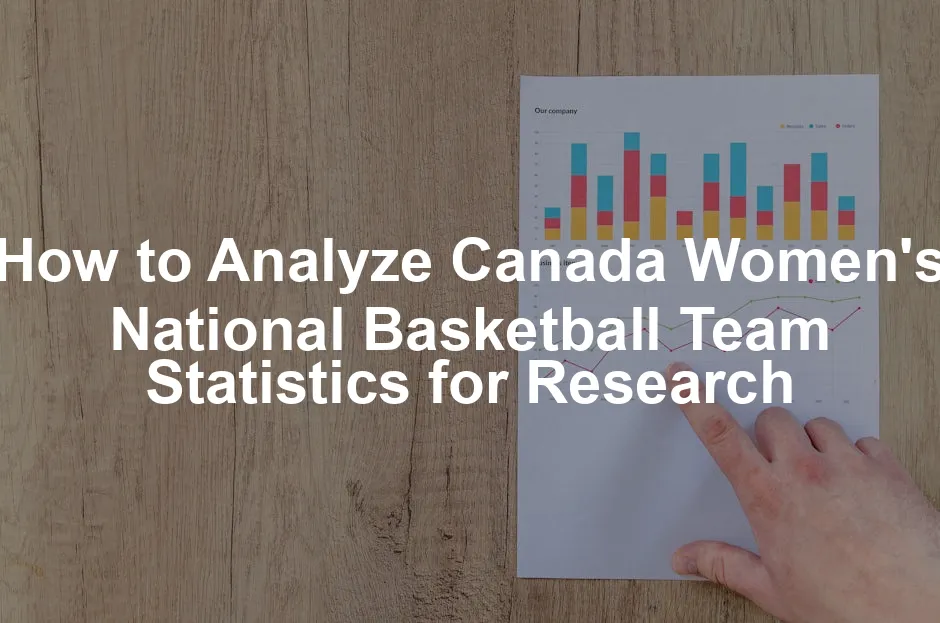Introduction
Analyzing sports statistics is crucial, especially in women’s basketball. Numbers tell stories, revealing insights about player performance, team strategies, and overall game dynamics. They transform abstract plays into concrete evaluations, allowing teams to fine-tune their approaches and enhance competitive edge.
The Canada Women’s National Basketball Team has seen remarkable growth. With each tournament, they’ve showcased talent and determination, making their mark on the international stage. This rise underscores the importance of statistical analysis. By scrutinizing game data, fans and analysts can better understand the team’s journey and performance.
This article aims to provide a comprehensive guide on analyzing statistics for the Canada Women’s National Basketball Team. We’ll break down essential metrics, identify key performance indicators, and offer tools for effective research. Whether you’re a researcher, coach, or fan, understanding these statistics will enrich your appreciation of the game and its players. an introduction to statistical learning with python book length

Understanding the fundamentals of statistical learning can greatly enhance your analysis of basketball statistics. an introduction to statistical learning with python book length
Understanding Basketball Statistics
What are Basketball Statistics?
Basketball statistics are numerical representations of player and team performance. They serve as the backbone of any in-depth analysis, offering insights into various aspects of gameplay. Basic statistics include points scored, rebounds, and assists. These metrics provide a snapshot of overall performance but can lack depth.
Advanced statistics take analysis further, introducing metrics like Player Efficiency Rating (PER) and Box Plus/Minus (BPM). These numbers account for nuances in gameplay, illustrating how individual contributions affect team success. Understanding both basic and advanced statistics is key for anyone looking to analyze the Canada Women’s National Basketball Team effectively.
Basic statistics offer immediate insights. For example, points per game (PPG) reflects a player’s scoring ability. Rebounds indicate a player’s effectiveness in securing possession. Assists showcase playmaking skills, revealing how well players collaborate on the court.
On the other hand, advanced statistics delve deeper. PER summarizes a player’s overall contributions into a single number, while BPM assesses how much a player contributes to team scoring relative to the average player. These advanced metrics provide a more nuanced view of performance, allowing for better comparisons across players and teams.
Understanding these statistics is essential for conducting thorough research on the Canada Women’s National Basketball Team. By leveraging both basic and advanced metrics, analysts can paint a clearer picture of the team’s strengths, weaknesses, and areas for improvement. This knowledge fosters better strategies and enhances overall performance, making it valuable for coaches, players, and fans alike.

Key Performance Indicators (KPIs)
In the realm of basketball analysis, Key Performance Indicators (KPIs) serve as the backbone for evaluating player and team performance. These metrics provide essential insights into how well a team or individual is performing, making them invaluable for coaches, analysts, and fans alike.
Let’s break down some crucial KPIs relevant to the Canada Women’s National Basketball Team.
Points Per Game (PPG) is a fundamental metric that measures a player’s scoring ability. It reflects the average number of points a player scores in a game. A high PPG indicates a player’s offensive impact and ability to convert opportunities into points. For the national team, a solid PPG from key players can be a game-changer in tight contests.
Field Goal Percentage (FG%) quantifies shooting efficiency. Calculated by dividing the number of successful field goals by the total attempts, FG% reveals how effectively a player or team converts scoring chances. A higher FG% signifies better shooting accuracy and contributes significantly to overall team success. When the Canada team showcases a high FG%, it often correlates with winning performances.
Three-Point Shooting Percentage (3P%) has become increasingly pivotal in modern basketball. This metric highlights a player’s ability to hit shots from beyond the arc, a vital skill in today’s game. Teams that excel in 3P% can stretch defenses, creating more scoring opportunities and changing the dynamics of the game.
Assists reflect a player’s playmaking skills. They indicate how well a player can facilitate scoring opportunities for teammates. A high assist count often corresponds with strong team chemistry and offensive flow, essential for a cohesive unit like the Canada Women’s National Basketball Team.
Rebounds, both offensive and defensive, are critical for controlling the game. Offensive rebounds provide second-chance points, while defensive rebounds prevent opponents from scoring. A team that excels in rebounding can maintain possession and dictate the pace of play.
Steals and Blocks are defensive metrics that showcase a player’s ability to disrupt the opposing team’s offense. High numbers in these categories indicate aggressive defense and can swing momentum during critical moments of a game.
Turnovers measure how often a player or team loses possession without scoring. A high turnover rate can be detrimental, leading to missed scoring opportunities and giving opponents easy chances. Minimizing turnovers is vital for maintaining offensive efficiency.
These KPIs are just the tip of the iceberg. They enable a deeper understanding of the dynamics at play on the court and help analysts and fans alike appreciate the nuances of the Canada Women’s National Basketball Team’s performance. By focusing on these metrics, one can gain valuable insights into what drives success in women’s basketball, setting the stage for future victories.

Historical Context of Canadian Women’s Basketball
Milestones and Achievements
Canadian women’s basketball boasts a rich history filled with significant achievements and milestones. It’s a journey marked by impressive performances, resilience, and the emergence of trailblazers who paved the way for future generations.
One of the earliest highlights came in 1924 when the Edmonton Commercial Graduates, affectionately known as the “Grads,” represented Canada at the Paris Olympics. This team not only made history by being one of the first Canadian women’s teams to compete at the Olympic level but also returned as champions, winning every match and solidifying their legacy. Naismith himself praised them as the finest team ever.
Fast forward to the 1970s, Canadian women’s basketball began gaining international recognition. In 1976, women’s basketball was introduced to the Olympics, and Canada made its debut in the tournament. Throughout the years, the national team has participated in multiple Olympic Games, with their best finish being fourth place in 1984.
The 1979 and 1986 FIBA World Cups saw Canada secure third-place finishes, further establishing the nation as a formidable force in women’s basketball. These accomplishments were pivotal in raising the profile of women’s sports in Canada.
Over the years, numerous players have emerged as icons of the sport. Notable players such as Kelly Boucher, who joined the WNBA shortly after its inception, and current stars like Kia Nurse and Natalie Achonwa have made significant contributions. Nurse, for instance, has not only excelled on the court but also serves as a mentor for aspiring athletes through initiatives like Kia Nurse Elite, a youth basketball program.
The last decade has marked a renaissance for Canadian women’s basketball. The national team has consistently qualified for major international tournaments, including the Olympics and FIBA World Cup. In 2015, they clinched gold at the Pan American Games, showcasing their growth and determination. A commendable fourth-place finish at the 2022 FIBA World Cup demonstrated their competitiveness on the global stage.
As we look toward the future, Canadian women’s basketball is poised for even greater success. With the development of young talent and increasing visibility, the sport is on an upward trajectory. The passion for basketball in Canada continues to grow, promising a bright future for the women’s game as they aim for podium finishes in upcoming tournaments, including the 2024 Paris Olympics.
The remarkable journey of Canadian women’s basketball is not just about the trophies won; it’s about the impact on society, the breaking of barriers, and the inspiration provided to countless young girls dreaming of basketball greatness. The milestones achieved thus far lay a strong foundation for the next generation of athletes.
Current Standing in International Competitions
The Canada Women’s National Basketball Team is currently ranked fifth in the FIBA world rankings. This impressive position reflects their ongoing improvement and consistency in international competitions. Recently, the team made headlines with their stellar performance at the FIBA Women’s World Cup. They reached the semifinals, showcasing their skill and determination against some of the best teams globally.
In addition, the Canada women’s team also competed in the Olympic Games, where they have consistently qualified over the past few years. Their best Olympic finish was fourth place in 1984, but they are on a mission to change that narrative. With increasing talent and a strong coaching staff, the team looks promising for future tournaments.

Sources of Data for Analysis
When it comes to analyzing the Canada Women’s National Basketball Team statistics, reliable data sources are crucial. Here are some top-notch places to find the stats you need:
Canada Basketball is the official governing body for the sport in Canada. Their website provides up-to-date statistics on player performances, team records, and historical data. This is your go-to source for comprehensive information on all levels of Canadian basketball.
FIBA (International Basketball Federation) is another vital resource. They maintain global rankings, tournament results, and detailed statistics, including game-by-game breakdowns. Their database is a treasure trove for researchers and fans alike.
NCAA also plays a significant role, especially for Canadian athletes in college basketball. Many players transition from the NCAA to the national team, making this data valuable for understanding their development and performance trends. ncaa softball statistics

Exploring NCAA statistics can provide valuable insights into the development of players who transition to the national team. ncaa softball statistics
Using official data is essential for credible research. It ensures that the analysis is based on accurate and verified information. Official statistics also provide a standardized metric for comparing performances over time and across different competitions.
In addition to these sources, various analytics platforms offer insights into advanced statistics. Websites dedicated to sports analytics can provide deeper dives into performance metrics, helping to reveal trends that basic statistics might overlook.
By utilizing these reliable sources, researchers can make informed conclusions about the Canada Women’s National Basketball Team’s performance and the factors that influence their success on the international stage. Accurate data analysis not only aids in understanding past performances but also helps in strategizing for future competitions.

Data Extraction Techniques
When it comes to analyzing statistics for the Canada Women’s National Basketball Team, data extraction is a crucial first step. You can employ several methods to gather the necessary statistics, with web scraping and APIs being the two most popular techniques.
Web Scraping is an automated way to gather data from websites. It involves writing scripts that can navigate through web pages, locate the data you need, and extract it. Python is a go-to language for this task, thanks to libraries like BeautifulSoup and Scrapy. BeautifulSoup allows you to parse HTML and XML documents easily. Meanwhile, Scrapy is a powerful framework for building web crawlers. With these tools, you can pull in game stats, player profiles, and historical data with just a few lines of code.
If your focus is on structured data from well-maintained databases, APIs (Application Programming Interfaces) can be your best friend. Many sports organizations, including FIBA and Canada Basketball, offer APIs that provide real-time statistics and player information. Using APIs means you can access live data without worrying about web scraping’s potential pitfalls, like changes in website layout. Programming languages like Python and R offer libraries like requests and httr for easy API integration.
R, in particular, is excellent for statistical analysis once you’ve gathered your data. It has powerful libraries for data manipulation and visualization, such as dplyr and ggplot2. Whether you prefer Python’s programming flexibility or R’s statistical prowess, both languages can effectively streamline your data extraction and analysis workflow.
By utilizing web scraping and APIs, you can efficiently gather comprehensive statistics on the Canada Women’s National Basketball Team. This foundational step sets the stage for insightful analysis, enabling you to draw meaningful conclusions from the data you collect.

Methods of Analyzing Statistics
Descriptive Analysis
Descriptive analysis is where the magic of numbers begins. This method summarizes your data in a way that’s easy to understand. When assessing the Canada Women’s National Basketball Team, you’ll want to focus on basic metrics that reflect team performance.
First up is average points scored per game. This metric provides a clear indication of a team’s offensive capabilities. If the Canada team averages over 80 points per game, they’re likely doing something right on the offensive end.
Next, let’s look at rebounds. This statistic encompasses both offensive and defensive rebounds. A team that excels in rebounding controls the game’s tempo and often limits opponents’ second-chance opportunities. Tracking average rebounds can help determine if the team is effectively securing possession.
Field goal percentage (FG%) is another fundamental metric. It shows how efficiently the team converts shooting opportunities. A higher FG% indicates that players are making their shots, which is vital for winning games.
You can also analyze the assists per game, a great indicator of teamwork. A high number of assists often correlates with effective ball movement and player collaboration on the court. If the Canada team consistently posts high assist numbers, it signifies strong chemistry among players.
Lastly, don’t overlook turnovers. This stat reflects a team’s ability to maintain possession. A high turnover rate can be detrimental, leading to missed scoring chances. By summarizing these metrics, you can create a comprehensive picture of the team’s performance.
In essence, descriptive analysis transforms raw data into meaningful insights. It allows coaches, fans, and analysts to quickly grasp how the Canada Women’s National Basketball Team is performing. By focusing on average points, rebounds, field goal percentage, assists, and turnovers, you can evaluate their strengths and weaknesses effectively. This foundational understanding paves the way for more complex analyses down the road.

Comparative Analysis
When analyzing the Canada Women’s National Basketball Team, comparing their performance against international peers is essential. This helps identify where they stand on the global stage. Start by examining statistics from major tournaments like the FIBA World Cup and the Olympics. Look at metrics like points per game (PPG), shooting percentages, and rebounding stats. Comparing these figures against teams from the USA, Australia, and Spain will provide insights into the competitive landscape.
Benchmarking historical data is another effective technique. Review past performances of the Canadian team in various championships. For instance, how did their PPG change from the 2016 Olympics to the 2022 World Cup? This analysis reveals trends over time, highlighting improvements or areas needing attention. By assessing these historical comparisons, you can create a clearer picture of the team’s development and establish realistic goals for future tournaments.

Advanced Statistical Techniques
Advanced statistical methods are game-changers in sports analytics. One key technique is regression analysis. This method examines relationships between different performance metrics. For example, it can show how shooting efficiency correlates with winning games. By applying regression models to the Canada Women’s National Basketball Team’s stats, you can uncover which factors most significantly impact their success.
Another vital method is cluster analysis. This technique groups players based on similar performance characteristics. For instance, you can categorize players by offensive contributions or defensive skills. This approach helps coaches understand the strengths and weaknesses within the team more clearly.
Using these advanced techniques allows for deeper insights into team strategies and player efficiencies. Coaches can make informed decisions based on data analysis, optimizing game plans and player rotations. The application of these methods transforms raw statistics into actionable strategies, crucial for enhancing the team’s overall performance.

Please let us know what you think about our content by leaving a comment down below!
Thank you for reading till here 🙂

For those looking to improve their game, consider investing in a Basketball Training Equipment Set. It includes everything from cones to agility ladders, ensuring you can sharpen your skills and impress on the court.
Have you ever thought about how to enhance your shooting skills? A Basketball Shooting Machine could be your new best friend. It allows you to practice your shots repeatedly, perfecting your technique and increasing your confidence for game day.
Don’t forget to stay hydrated while you’re training! A Sports Water Bottle with Infuser can make your hydration routine a bit more exciting by allowing you to add fruits for some extra flavor.
If you’re serious about basketball, consider diving deeper into the stats with a copy of Sports Data Analysis: Techniques and Applications. This book provides in-depth insights into the methodologies used in sports analytics, perfect for coaches and aspiring analysts.
For those interested in the psychological aspect of sports, Sports Psychology: Mental Training for Athletes is a fantastic resource that can help athletes develop their mental game, ensuring they perform at their best under pressure.
And for the fashion-savvy athlete, check out the Women’s Basketball Jerseys (Canada National Team) to show your support while looking fabulous!
Finally, if you’re looking for a fun way to unwind after practice, consider a Basketball Themed Puzzle! It’s a great way to relax and still keep your love for the game alive.
All images from Pexels




